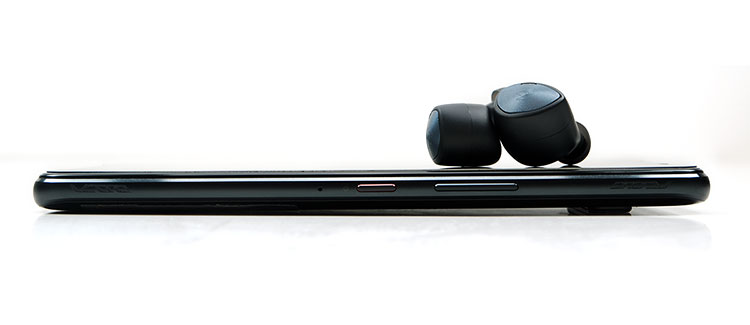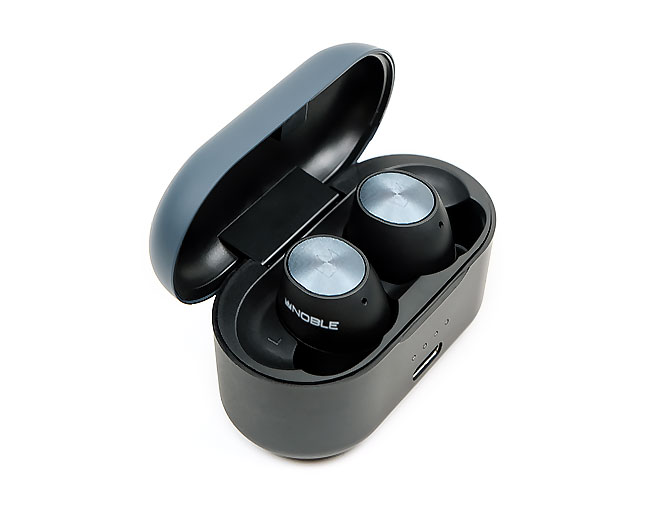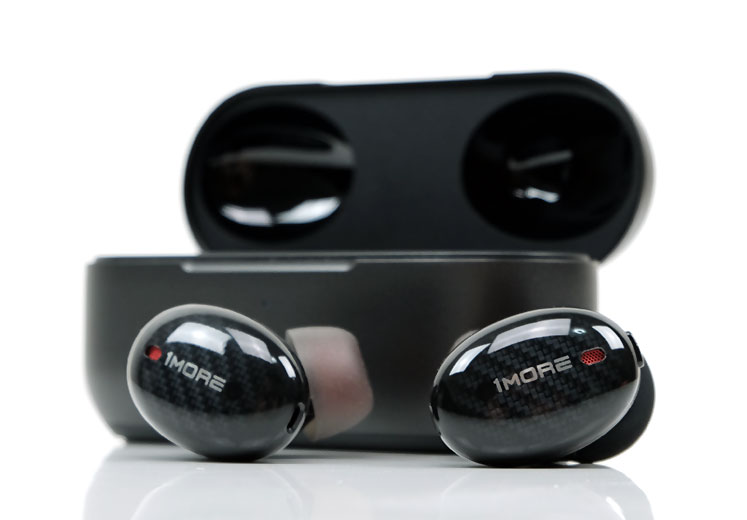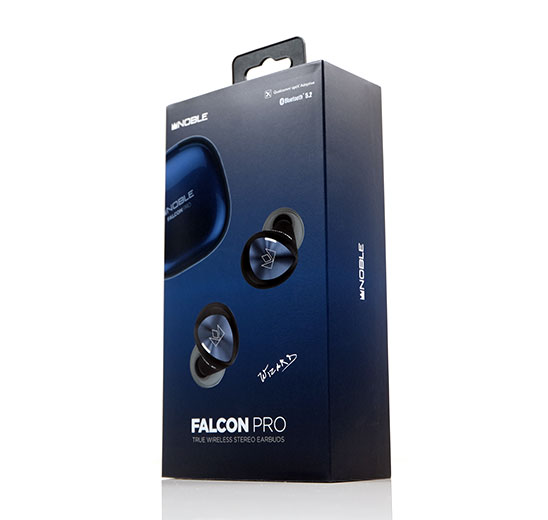Sound Impressions
Summary
The Falcon Pro delivers a high contrast tone with emphasized low-end power and energetic treble overtones. This is a classic V-shaped delivery but not in the same manner as the original, which, you can read in more detail in our comparison section below.
The triple driver combo and aptX adaptive performance create a much better sense of scale, dynamic range, and clarity over a lot of previous TWS we have reviewed to date. This is an open-sounding and holographic presentation but also a lively and clean sound as opposed to rounded, warm, or dark.
In terms of overall response, the dynamic driver tuning is refreshingly bloom-free with more sub-bass emphasis sub-100Hz than a mid-bass hump creeping into the upper bass. It also sounds quite tight with excellent separation and layering from the bass to mids and not a huge amount of decay.
Mid-bass to lower-mids sounds quite neutral to relatively dipped with instrumental body sounding a bit lean and pushed back. Post 1k you get that usual elevation which sounds like it continues right up into the upper mids with a peak somewhere around 3-5k. Vocals are clean and clear also with higher-pitching vocals post-1k further forward in terms of staging.
Beyond the mids, the treble retains some strong energy with a narrow peak around 8-10k that you can pick up in the upper-mids overtones and general coloration. Though it adds some extension and enhanced air over the original Falcon, the Falcon Pro treble is really
Timbre
The timbre of the Falcon Pro is very much to the cool side with a strong bass and treble emphasis creating a high level of contrast on instruments and vocals.
The fundamental on lower notes is excellent with plenty of power on kick drums and bass synth notes. More than that it’s not a muddy-sounding rounded boom but clear and tight with a fast transient response for a TWS driver implementation. I really like this Falcon Pro dynamic driver for its low-end speed and definition.
However, the influence of the second harmonic order in the Falcon Pro’s timbre are secondary to the level of contrast so there is not a huge amount of warmth or sustain. (body), through the midrange notes. This means less of a euphonic tone, a slightly drier vibe with more upper-order harmonics creeping in.
The Falcon Pro BA timbre comes shining through the further up the FR the note strikes, so whilst the clarity is excellent you might find the brightness on some female mix and head voices to be more dominant in the harmonic balance.
That means percussion articulation is very clean and fast but a bit light in their body with some instances of splashy energy coming to the fore. Natural sibilance a bit more emphasized in some vocal performances also.
Staging
The Falcon Pro has one of the best staging performances I have heard to date from a TWS. That triple driver implementation, V-shaped curve, and high contrast clean tuning really maximizes the space quite well.
You get a strong sense of depth and great top-end headroom with clarity through the mids. Definitely a more holographic performance with better detail retrieval and dynamic range over the original Falcon. Lower-mids to around 1k as you would expect sound relatively dipped and pushed further back in the mix so not a huge amount of presence in this region.
Noble has kept a strong emphasis on instrumental separation despite the heavy sub-bass and treble energy with vocals able to stand out quite easily, especially higher-pitching vocals which sound quite forward and vivid in their delivery.
The more aggressive treble will also help greatly in picking up nuanced imaging cues swirling from left to right that might not be so noticeable on the softer and darker sounding original Falcon.
Wireless Performance
Pairing
This is a familiar pairing process, one that starts with a basic pairing in your phone’s BT setup then a secondary pairing with the Sound Suite app.
The phone pairing with the new unified single label for the Falcon Pro is dead easy on all sources including Windows 10. The original Falcon had a left and right and for the life of me, I could never remember which one I should pair with first. The Falcon Pro single label takes that old man’s confusion away.
The second app pairing, I found just a little bit inconsistent but not unworkable. Basically, you place both drivers near your phone ensuring they are paired with your phone, and power up the app to pair.
The app will then prompt you to turn on your GPS and location services before trying to locate the Falcon Pro. If it does you get an additional pairing request then once done it should show up in the app menu.
This is quite similar to how the Sony WF-1000XM3 and 1MORE’s True Wireless ANC pair with their respective apps. Generally, the pairing was smooth but a few times it would not find the Falcon Pro or it would say not found then suddenly the Falcon Pro screen would pop up as found.
Also, when multi-point pairing the original Falcon and the Falcon Pro on some phones there would be a lot of disconnection and repairing prompts, (Asus ROG Phone 3). DAP such as the new iBasso DX300 would connect but tracks in Mango would play but with no audio. Others worked just fine like an older Huawei P20 and HiBy’s R8 DAP.
Stability & Range
The Falcon Pro is rock steady up to 9-10m with 3 tested sources, an Asus Rog Phone 3, Huawei P20, and the HiBy R8 DAP. The R8 was perhaps the weakest of the 3 pairings with a tiny bit of drop out at 10m but understandable as I find DAP BT implementations to be generally weaker than smartphones.
Of the 2 smartphones, the Asus Rog Phone 3 had the most stable connection with the strongest signal at up to 13 meters with 2 walls whereas the P20 had signal drop out around 11-12m.
Latency
The QC3040 chipset aptX Adaptive latency is advertised at around 80ms and to be honest I found the Falcon Pro to be fairly tight for audio sync on Windows 10 via BT for latency on our tested media files and Netflix.
Overall, you can get away without much adjustment in terms of ms hasten on VLC. I would say a max of 0.2ms hasten to make it super tight but at 0.0ms it is noticeably tighter than the 1MORE True Wireless ANC for local files and a little more in sync for online media such as Netflix compared to the Sony WF-1000XM3.
Select Comparisons
Noble Audio Falcon
$156
Technical
The original Falcon only came out last year and marked Noble’s debut entrance into the True Wireless System market. It was a fine effort based on my own original review but a product fairly consistent with where the TWS market was at the time.
In terms of tech, the Falcon is a single 6mm Dual-layered Carbon dynamic driver compared to the far more evolved Falcon Pro’s triple hybrid single 6mm tri-layered titanium-coated dynamic driver and the latest generation “SRDD” Knowles dual BA driver.
Decoding covers similar codecs only this time the Falcon Pro decodes up to aptX Adaptive with a potential 24BIT/48K rate when possible. The original Falcon only offers a max of aptX TWS+. The Falcon Pro also offers the new Hear Through ambiance mode which the older model does not.
Both TWS models have opted for TrueWireless Stereo Plus though I think only the Falcon Pro offers the mirroring option. Certainly, the original Falcon does not give you a single label when pairing so it is much simpler working with the Falcon Pro.
Battery life for both is excellent and quite similar at around 9-10 hours with up to 30 in the cradle. Both TWS also use the excellent Sound Suite but only the Falcon Pro has access to the Hear Through and the Master Gain Setting.
Design
From afar they look quite similar but closer up the Falcon Pro is just marginally taller on the main shell and perhaps a thicker nozzle but it is very subtle. It does indeed secure better than the original with superior isolation also.
Design-wise the Falcon has those rounded plates that dual as push-button controls whereas the Falcon Pro has the snazzier teardrop faceplate designs. The cradle on the Falcon Pro is also better quality than the smaller Falcon version albeit a little bigger.
The internal driver bays also have better depth on the Falcon Pro version for 3rd party tips to fit in whereas the original Falcon case is much tighter only allowing for the stock ePro tips.
Performance
Tuning
Both have a similar bias with a V-shaped response curve but right away you can tell the Falcon Pro is a much better technical performer compared to the original Falcon.
The new 6mm dynamic driver of the Falcon Pro for a start sounds much tighter, creating a deeper more powerful rumble but at the same time not so much bloom and lengthy decay. It creates a stronger sense of space and separation compared to the original.
Up top, the Falcon Pro is brighter but also more extended so it creates the perception of a taller airier sound stage compared to the stronger treble fade of the original. Mids also have better energy and separation with vocals further to the fore on the Falcon Pro.
Overall, the Falcon staging is more holographic to my ear with stronger depth, more top-end energy, and a cleaner mids with better separation.
However, some people might prefer the timbre of the original over the higher contrast levels of the Falcon Pro. The Falcon Pro loses a bit of that original’s warmth in favor of resolution and speed. Vocals and percussion can fizz a bit more and become much more aggressive.
The original Falcon lacks the resolving capability and may not have the same presence but its warmer softer vocal and percussion timbre make for a more forgiving listening experience.
Sony WF-1000XM3
$229
Technical
Released in 2019 and still a benchmark for many through 2020, the Sony WF-1000XM3 TWS rightly took our TWS Top Gear Award for 2020 with its performance and features.
A key thing to note that is everything about the Sony TWS is in-house designed and made, nothing outsourced in terms of developments. That includes a 6mm single dynamic driver with a dome type (CCAW Voice coil) and Neodymium magnet build.
The Falcon also offers a 6mm dynamic driver but it’s a Tri-layered Titanium-coated Driver with an additional 2 BA which should give it a very different flavor to the Sony, (see tuning below).
The Falcon Pro does offer a best-in-class BT5.2 aptX Adaptive coding capability compared to the more modest BT5.0 SBC/AAC capability of the Sony TWS, however, I have never found that a barrier with a good driver implementation in a TWS.
On the flip side, Sony’s main DAC and amp chipset, the HD Noise Canceling Processor QN1e can handle 24-bit Audio Signal Processing as well as upscale as and when required with the use of DSEE HX. Critically for many, the WF-1000XM3 can also ANC and adaptive ambient modes whereas the Falcon Pro only offers ambient via Hear Through.
Both have app’s and whilst I think the Noble Sound Suite is clear, easy to use, and attractive looking I have to give props to the Sony app which is the most feature-rich of any TWS app I have reviewed to date. Features such as Cloud storage for unique settings and the 3D Reality Audio Suite supporting 360 tracks in the likes of Deezer are incredible.
Design
And here is where the Falcon Pro storms all over the Sony with its comfier fit, deeper more secure nozzles, and better passive isolation. The Sony ANC levels it up for me, perhaps a slight edge in the way it suppresses a lot more background noise compared to the Falcon Pro but without, the Falcon Pro is way superior.
The Sony design is still quite unique but it lacks IPX so very much not an element-resistant design. Battery life is also superior on the Falcon Pro despite having a smaller cradle at 30 hours compared to just 18 on the Sony.
Without the ANC the Sony’s are competitive at 8 hours but with ANC you just get 5 so bet on the Falcon Pro if you need a longer battery cycle. The Falcon Pro’s are also wireless charging capable, something which the Sony lacks.
Performance
The Sony has the more ‘audiophile’ or balanced tuning but the Falcon Pro is clearly more resolving with a better dynamic range from that aptX adaptive mode and triple driver combo.
On the FR side, the Falcon Pro is more V-shaped compared to the subtle U or flattish M-shape of the Sony. The Falcon’s extended lows and highs offer more timbral contrast with a vivid exciting tone compared to the balanced and slightly warmer vibe of the Sony.
You are going to hear more depth and power on the Falcon Pro, a stronger perception of air also with a better holographic staging quality. The Sony’s SBC does remarkably well but its dynamic range is not quite on the same level sounding more compressed.
Having said that the Sony FR tuning has less of a mids-dip and a comparatively subdued but warmer bass response which jives well with a wider range of genres. Sony’s lower-mids timbre is also a little thicker, smoother, and with more presence compared to the recessed and lean instrumental body from the Falcon Pro.
Interestingly, both have a bit of sizzle in the treble but the Sony 7k peak is quite narrow so it doesn’t create an all-encompassing upper-order harmonic overtone through the mids timbre. The Falcon Pro does that a bit more so whilst vocals are further forward on the upper register and definitely more vivid they are also a little sharper and more aggressive sounding.
1MORE True Wireless ANC Review
$199.99
Technical
The 1MORE True Wireless ANC is the company’s flagship TWS and like the Falcon Pro, it is also a multi-driver design though priced a fair bit cheaper. Inside the 1MORE, you get get a dual-driver configuration with a larger 10mm dynamic driver for the lows and a single proprietary designed BA for the highs.
The Falcon Pro uses a small 6mm dynamic for the lows and mids, and a dual BA for the highs. Both dynamic drivers are titanium designs though I dare say the Noble Tri-layered Titanium-coated element is a bit more sophisticated in the application.
Both TWS are capable of up to aptX decoding though the 1MORE uses the standard aptX codec via BT5.0 whereas the Falcon Pro uses aptX Adaptive with a more modern BT5.2 output. The two TWS are capable of offering ambient modes for external noise awareness though the 1MORE goes significantly further with ANC.
Apps are available for the two TWS with some features overlap. For Hear Through on the Falcon Pro, you have 1MORE’s Pass-Through equivalent as well as offering OTA firmware upgrades and battery status of the drivers. The Noble Sound Suite does offer better sound control with EQ and master gain settings as well as better key configuration control.
Design
The Falcon Pro is taller but not as big overall compared to the 1MORE. The 1MORE main shell is quite bulky with a far shorter nozzle. The supplied O-Rings do help keep everything nicely in place but without they are really difficult to keep securely in place.
No such issues with the comfier better fitting Falcon Pro. It may not have ANC but the passive noise performance is far superior to the 1MORE without ANC. Also, the ePro tips are comfier than the stock tips on the 1MORE.
Both offer a tap touch control and neither are hugely sensitive so it is about even here for me. What I do love is the 1MORE’s aluminum, smooth curved, and nicely finished cradle. It is a little heavier than the Falcon Pro cradle and bigger but still very pocketable as well as being more durable.
Both cradles also offer Qi Wireless charging with USB-C ports. The 1MORE seems to have quick charging capability but its cradle capacity is shorter at 22 hours compared to 30 for the Falcon Pro. Driver cycles are much superior on the Falcon Pro at up to 11 hours compared to just 6 for the 1MORE with ANC off.
Performance
Tuning
Again, two V-shaped performers here except the 1MORE is probably a bit more exaggerated sounding with a boomier slower low-end using that larger dynamic driver. I suspect the crossover to the BA is probably quite high as you get more dynamic timbre through the mids but it is not as precise sounding as the Falcon Pro.
The Falcon Pro does not have quite the same bloom or warmth, and perhaps a shade less sub-bass also. However, you might notice that less in favor of the far tighter bass reflex and generally faster sounding low-end. You get a far superior level of separation from bass to mids and sans bloom, they also have a bit more clarity compared to the 1MORE.
With an additional BA driver Noble can create a bit more distinction in the upper mids whereas you get the feeling the 1MORE struggles to be heard sounding thinner and more diffuse just before the single BA takes over.
Both have a peppy treble tuning with plenty of contrast in the timbre. I would say the Falcon Pro sounds a bit brighter and the 1MORE a bit softer to my ear but I think I prefer that brighter tone to the indistinct performance of the 1MORE treble. The Falcon Pro just resolves better for me compared to the vague delivery of the 1MORE mids and treble.
Our Verdict
Noble are really taking this TWS business quite seriously. The Falcon Pro sound is the most technically capable I have heard to date from a TWS and I have heard quite a few I can assure you. The level of resolution, strong dynamic range, and impressive clarity is way above the original Falcon.
The overall tone and timbre might be a ‘take or leave it’ thing based on personal preference. I do suggest a bit of EQ from the Sound Suite or PMEQ if the treble is a bit too bright or aggressive. I guess Noble went for this tuning to tease out as much perceived clarity as they could from the dual BA driver design.
Let’s not forget, the Falcon Pro also comes equipped also with IPX5, above-average battery life, and some stellar passive isolation to compensate for the lack of ANC. This is a fairly complete package, to be honest, and definitely a pro-audiophile standout TWS choice for 2021.
Noble Audio Falcon Pro Specifications
- Chipset: Qualcomm QCC3040 (TrueWireless Mirroring)
- Driver: Knowles SRDD BA Drivers & 6mm Tri-layered Titanium-coated Driver (TLT Driver)
- Playback frequency: band 20Hz-24,000Hz
- Microphone Omnidirectional / Qualcomm CVC8.0 with noise-canceling
- Bluetooth specifications Version5.2 / Class2 / Multi-pairing support
- Bluetooth profile A2DP, AVRCP, HSP, HFP
- Supported codecs SBC, AAC, aptX, aptX Adaptive
- Power supply Body: DC3.7V 60mAh lithium polymer rechargeable battery (built-in type)
- Charging case: DC3.7V 400mAh lithium polymer rechargeable battery (built-in type) with USB C connection and wireless charging
- Continuous playback time (maximum): 5.5 hours (at maximum volume) / 10 hours (at 70% volume)
- Continuous talk time (maximum): 11 hours (at 70% volume)
- Charging time: Earphone about 1 hour / Charging case about 1.5 hours
- Operating temperature range Celsius: 10 to 60 degrees (no condensation)
- Water resistance: IPX5
- Accessories: Charging case, pouch, earpiece (ePro: S / M / L), USB cable User’s Guide







